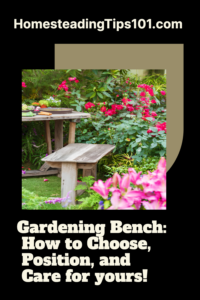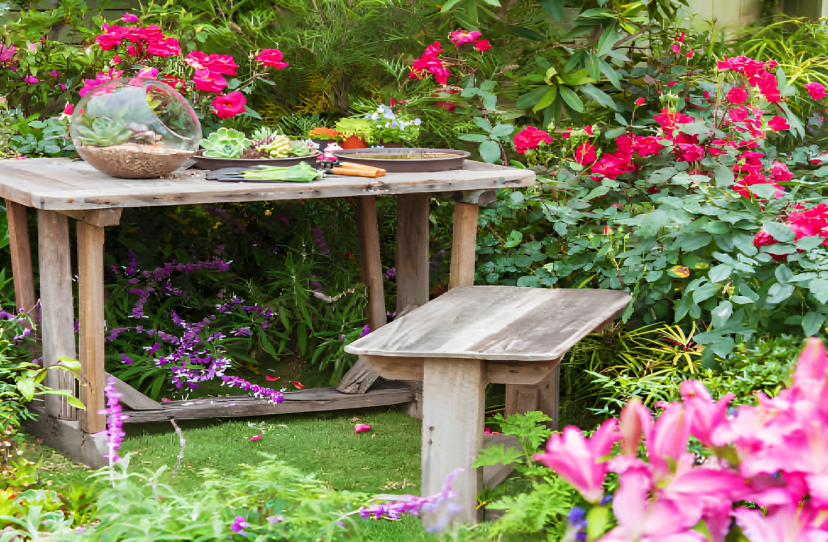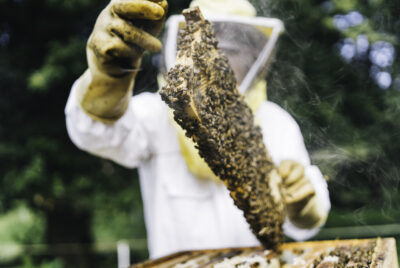How to Choose, Position, and Care for Your Dream Gardening Bench
"We may earn a commission from purchases made using our links. Please see disclaimer."
As an avid gardener, one of my favorite accessories for the garden is a sturdy and comfortable gardening bench. Not only does it provide a place to sit and take a break from gardening tasks, but the right bench can also add aesthetic appeal and valuable storage options. In this article, I’ll discuss the key reasons for installing a gardening bench and provide tips for selecting, placing, and caring for one.
Reasons for Getting a Gardening Bench
Comfort and Convenience
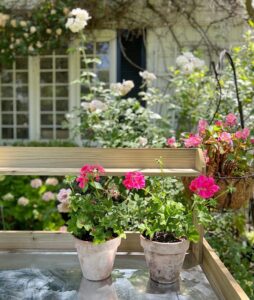 One of the best reasons for having a gardening bench is simply to create a comfortable spot to take a break from standing and working. Gardening often involves a lot of time on your feet digging, planting, weeding, and more. A high-quality bench with a contoured seat, supportive backrest, and armrests can provide a soothing place to get off your feet and recharge for a bit. Having a dedicated spot to sit makes it more likely you’ll actually take breaks and avoid fatigue.
One of the best reasons for having a gardening bench is simply to create a comfortable spot to take a break from standing and working. Gardening often involves a lot of time on your feet digging, planting, weeding, and more. A high-quality bench with a contoured seat, supportive backrest, and armrests can provide a soothing place to get off your feet and recharge for a bit. Having a dedicated spot to sit makes it more likely you’ll actually take breaks and avoid fatigue.
Benches strategically placed throughout the garden encourage you to literally stop and smell the roses. Position benches along winding paths or in fragrant garden rooms to create an immersive sensory experience. Opt for curved benches that wrap around trees or circular planter beds to increase the inviting ambiance. Even a simple concrete bench tucked among lush flower beds can provide a sweet spot to relax and unwind.
Aesthetic Appeal
A well-designed gardening bench can also add visual appeal and charm to your outdoor space. Rather than just using a basic plastic patio chair, choose a bench with elegant scrollwork, a vintage look, or colors that complement your garden’s palette. It will give your landscape personality and style. Go for a striking design that doubles as garden art!
Artistic benches featuring mosaic tile designs, hand-forged metalwork, or carved stone accents elevate your garden to a showcase worthy of public display. Integrate your bench into the overall landscape design both visually and physically using unifying colors, materials, and plantings. Enhance sightlines by aligning your bench with key focal points in the garden.
Additional Storage
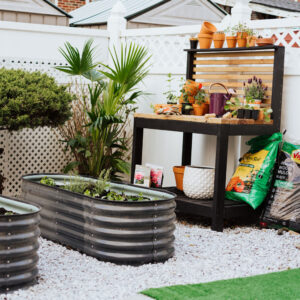 Benches with built-in storage compartments underneath the seat are extremely useful for keeping your most-used gardening tools and accessories close at hand, but out of sight. Look for options with lift-up lids, multiple shelves, and hooks to keep everything organized. Quick access to your tools will make gardening even more convenient. Strategic storage benches stationed around the garden minimize trips back to the potting shed. Stash pruning shears on a shady bench near bushes and trees, trowels and transplanters alongside vegetable beds, and watering cans near thirsty flower patches. Customize storage for each unique area. Add weatherproof locking lids or easily accessed open crates depending on privacy and security needs.
Benches with built-in storage compartments underneath the seat are extremely useful for keeping your most-used gardening tools and accessories close at hand, but out of sight. Look for options with lift-up lids, multiple shelves, and hooks to keep everything organized. Quick access to your tools will make gardening even more convenient. Strategic storage benches stationed around the garden minimize trips back to the potting shed. Stash pruning shears on a shady bench near bushes and trees, trowels and transplanters alongside vegetable beds, and watering cans near thirsty flower patches. Customize storage for each unique area. Add weatherproof locking lids or easily accessed open crates depending on privacy and security needs.
Considerations When Selecting a Gardening Bench
Size and Dimensions
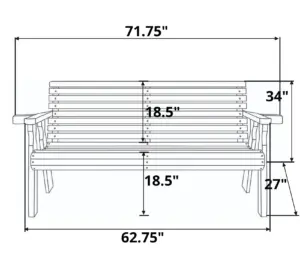 First, make sure to choose a gardening bench size that fits comfortably within your available space. Measure the location where you want to place it and opt for a compact narrow bench for smaller areas. For wider spots, select a full-length bench with a backrest for maximum comfort. Also, check the weight capacity to ensure it can support multiple people if needed.
First, make sure to choose a gardening bench size that fits comfortably within your available space. Measure the location where you want to place it and opt for a compact narrow bench for smaller areas. For wider spots, select a full-length bench with a backrest for maximum comfort. Also, check the weight capacity to ensure it can support multiple people if needed.
Focus first on proportion versus strictly size. An oversized bench crammed into a tiny space appears awkward, while a petite bench lost in a vast lawn looks oddly isolated. Choose bench dimensions and styles that mirror the surrounding hardscapes and plantings. For example, integrate an arched back bench among billowy flower beds versus a straight-lined bench flanking geometric pavers.
Material
Popular gardening bench materials include wood, metal, plastic, and resin. Wood looks most traditional, but requires more maintenance. Metal is very durable, but can heat up in the sun. Plastic is affordable but may look cheap. Resin provides a nice compromise, with the look of wood but without as much upkeep. Consider material weather resistance and your own visual preferences.
Prioritize eco-friendly sustainability in your bench material selection. Opt for durable recycled plastic, FSC-certified eucalyptus wood harvested from responsibly managed forests, or powder-coated aluminum containing recycled content. Your bench can make an environmental statement and set an example of green living for visitors.
Style and Design
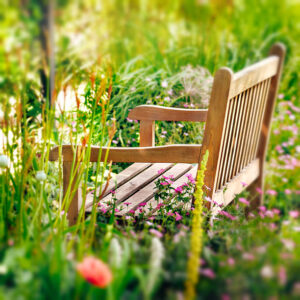 There are countless gardening bench styles to match any taste! Classic wooden designs with curved backs and slatted seats offer a timeless look. Arbors with built-in benches make a charming focal point. Colorful cabriole-style metal benches add a fun pop. Fieldstone and concrete benches integrate seamlessly into naturalistic gardens. Select a bench style that complements your personality and garden aesthetic.
There are countless gardening bench styles to match any taste! Classic wooden designs with curved backs and slatted seats offer a timeless look. Arbors with built-in benches make a charming focal point. Colorful cabriole-style metal benches add a fun pop. Fieldstone and concrete benches integrate seamlessly into naturalistic gardens. Select a bench style that complements your personality and garden aesthetic.
Eclectic gardens bursting with an energetic mix of plants, sculptures, and accessories call for an equally vibrant bench. Seek out eye-catching designs featuring bright rainbow colors, bold geometric patterns, or flashy metallic finishes. Contemporary gardens deserve sleek modern benches with clean lines and artistic flair. Match bench personality to the surrounding garden mood and themes.
Ideal Placement Options for a Gardening Bench
By the Garden Path
Situate your gardening bench along a garden path or sidewalk to create a welcoming spot to stop and enjoy the view. Place it facing outward toward the garden to provide the best vantage point. Having a bench along your walking route encourages you to take relaxing breaks during garden chores.
Shelter your meandering garden path bench beneath vine-covered pergolas or fruiting espalier trees. This allows you to smell sweet blossoms and pluck ripe fruit directly from above during rest stops. Flank the bench with pots of herbs or aromatic flowers to immerse visitors in sensory delights from all angles.
Against a Wall or Fence
 Positioning a bench with its back against a wall, trellis or fence provides extra support. This placement also allows you to include containers or planted areas on either side to make an inviting, secluded nook within your garden. Opt for a bench with a contoured backrest to increase comfort when seated against a hard surface. Choose bench materials and colors that seamlessly blend into permanent garden structures for a cohesive look. For example, pair a brown wooden bench against a matching cedar fence, or opt for a white ironwork bench framed by white arbor beams. Then weave coordinating vines or espaliers across the adjacent vertical surfaces to complete the unified theme.
Positioning a bench with its back against a wall, trellis or fence provides extra support. This placement also allows you to include containers or planted areas on either side to make an inviting, secluded nook within your garden. Opt for a bench with a contoured backrest to increase comfort when seated against a hard surface. Choose bench materials and colors that seamlessly blend into permanent garden structures for a cohesive look. For example, pair a brown wooden bench against a matching cedar fence, or opt for a white ironwork bench framed by white arbor beams. Then weave coordinating vines or espaliers across the adjacent vertical surfaces to complete the unified theme.
Under a Shade Tree
To avoid getting overheated while gardening, place your bench beneath a shade tree. This could be under the canopy of an existing mature tree, or you can situate a bench next to a newly planted smaller tree that will provide more shade as it grows. Having respite from the hot sun will make your gardening bench even more enjoyable to use.
Select trees with multi-season appeal like maple species that offer both spring flowers and fall foliage above your bench location. Or match bench style to the tree species – an English garden bench below a historic oak, or an Asian stone bench paired with a Japanese maple. Allow enough space between tree trunks and bench seating areas to prevent invasive surface roots from becoming an obstacle.
Recommended Gardening Bench Features
Contoured Seat
 Seeking out benches with contoured, ergonomic seat designs will maximize comfort, especially for longer sitting sessions. Contoured seats offer lumbar support and cradle your body naturally. Avoid flat, hard seats that could become uncomfortable over time. A contoured seat with a comfortable slight recline is ideal. See if manufacturer specifications include details like weight capacity, suspension systems, and type of cushioning materials used. Prioritize heavy-duty garden bench frames that can handle larger loads and won’t bend or warp under frequent use. Also, ensure cushions feature weather-resistant covers that repel rain and can handle intense sun without fading.
Seeking out benches with contoured, ergonomic seat designs will maximize comfort, especially for longer sitting sessions. Contoured seats offer lumbar support and cradle your body naturally. Avoid flat, hard seats that could become uncomfortable over time. A contoured seat with a comfortable slight recline is ideal. See if manufacturer specifications include details like weight capacity, suspension systems, and type of cushioning materials used. Prioritize heavy-duty garden bench frames that can handle larger loads and won’t bend or warp under frequent use. Also, ensure cushions feature weather-resistant covers that repel rain and can handle intense sun without fading.
Armrests
Benches with armrests provide a place to rest your arms while sitting, adding an extra element of relaxation and support. Armrests come in handy for providing leverage when getting on and off the bench too. Just make sure the armrest height matches the seat height comfortably based on your body size. Check if bench armrests shift out of the way or lift up to allow for unencumbered side access. This helps accommodate those with mobility challenges. Also, focus on ergonomic armrest shape and width – extended use of narrow or oddly angled rests can cause wrist strain or numbness in the hands.
Tool Storage
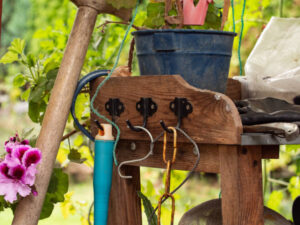 As mentioned previously, one of my top bench recommendations is choosing a style that incorporates storage space for gardening tools and accessories. Conveniently stashing your gloves, pruners, trowels, and other oft-used items means you can keep them close by but out of the way. Search for storage benches with lift-up lids, shelves, hooks, and more organizational features.
As mentioned previously, one of my top bench recommendations is choosing a style that incorporates storage space for gardening tools and accessories. Conveniently stashing your gloves, pruners, trowels, and other oft-used items means you can keep them close by but out of the way. Search for storage benches with lift-up lids, shelves, hooks, and more organizational features.
In wet climates, seek out waterproof storage benches to protect contents from rain and irrigation overspray. Make sure any bench lining won’t retain moisture or molds/mildews may result. Proper drainage and ventilation are key. Also, include storage benches in WiFi-enabled outdoor security camera coverage to deter potential tool theft.
Maintaining and Caring For a Gardening Bench
Weatherproofing
Regular weatherproofing and sealing will help protect your gardening bench from rain, snow, and sun damage. Wood benches in particular require occasional re-staining, sealing, or repainting to prevent cracking, splitting, and deterioration, especially on the seat where most of the wear occurs. Follow manufacturer directions for your specific bench material.
Use breathable finishes on wooden benches that allow moisture vapor to escape rather than trapping it inside. Also properly prepare surfaces prior to applying sealants by gently sanding and cleaning to remove existing finishes, loose debris, and flaky grains which could allow moisture intrusion underneath new layers.
Cleaning
 It’s important to periodically wash down your gardening bench to keep it free of dirt, debris, bird droppings, pollen, and other gunk which can stain and degrade the bench over time. Use a soft brush and mild soap and water to gently scrub the bench on an annual basis or as needed. Avoid harsh chemicals or abrasive brushes. For stubborn organic stains on wood or plastic benches, try using oxygenating cleaners containing sodium percarbonate to lift the marks without bleaching or wearing down the underlying surface. Rinse thoroughly after use. For metallic benches, apply a protectant polish once cleaning is complete to guard against future corrosion and tarnishing from weather exposure or irritating garden chemicals.
It’s important to periodically wash down your gardening bench to keep it free of dirt, debris, bird droppings, pollen, and other gunk which can stain and degrade the bench over time. Use a soft brush and mild soap and water to gently scrub the bench on an annual basis or as needed. Avoid harsh chemicals or abrasive brushes. For stubborn organic stains on wood or plastic benches, try using oxygenating cleaners containing sodium percarbonate to lift the marks without bleaching or wearing down the underlying surface. Rinse thoroughly after use. For metallic benches, apply a protectant polish once cleaning is complete to guard against future corrosion and tarnishing from weather exposure or irritating garden chemicals.
Repairs
Inspect your gardening bench regularly for any signs of damage, such as splintered wood, bent metal components, or broken plastic parts. Make timely repairs as needed to prevent further issues and keep your bench safe and functional. Common repairs include touching up paint, applying wood glue, replacing corroded hardware, and securing loose joints or connections. At the first sign of wobbliness in a previously sturdy bench, tighten up bolts that may have vibrated loose over time. This prevents escalating structural fatigue and damage. Also, fill any visible wood cracks with flexible sealants to compensate for swelling/contraction and avoid moisture penetration. Seek professional welding for broken or buckled metal legs.
Conclusion
Adding a gardening bench to your outdoor retreat provides comfort, convenience, and aesthetic appeal, while also offering handy tool storage. Take care when selecting a bench style and placement that perfectly suits your space. And be sure to regularly maintain your bench to extend its good looks and functionality for many gardening seasons to come. A quality garden bench is an investment that’s well worth the effort! Let me know if you have any other gardening bench tips or questions. Happy gardening!
FAQs
Q: What is the best material for outdoor gardening benches?
A: The best materials are weather-resistant ones like metal, plastic, resin, and properly sealed, maintained wood. Avoid upholstered cushions which can get moldy.
Q: Should I choose a portable or stationary garden bench?
A: Stationary benches with solid, heavy bases tend to be sturdier and lower maintenance. But portable options allow you to move them around your garden as needed.
Q: What is a good size for a gardening bench?
A: Look for benches around 4-6 feet long and 2-3 feet deep to accommodate 1-3 people comfortably. Measure your space first to ensure a proper fit.
Q: Should I use a gardening bench as extra seating when entertaining?
A: Absolutely! A sturdy, well-made gardening bench adds great extra seating for entertaining guests outdoors. Just hose it off to remove dirt if it’s been used for gardening tasks.
Q: What are some good DIY gardening bench ideas?
A: Old wooden pallets, concrete blocks, fieldstones, straw bales, and salvaged wood or metal can be repurposed into creative DIY gardening benches. Get inspiration from gardening websites and blogs for ideas.
